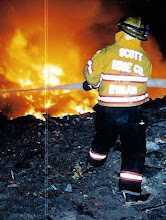Overhaul can be hard, dirty, nasty work. It’s a time when many tired firefighters get
injured. On heavily damaged structures
it can be highly challenging. One bad
habit some departments get into is substituting the use of Class A foam for
good overhaul practices. “Just soak the
hell out of it. The foam will take care
of it,” is something I’ve heard more than once.
Sorry, but there is no substitute for good overhaul—period. This is not
a “how to” piece, just a suggestion to refocus on an important ingredient in
the recipe.
It can present a great learning opportunity for
inexperienced firefighters. They can
learn about fire behavior, travel, construction types, cause and origin, and
myriad other topics. Nothing says that
the officer supervising them has to remain silent. He or she can talk about all these things
while the crew works, using things they find as examples. We have great tools today, unavailable years
ago, such as thermal imaging cameras, but even this can be a crutch for proper
overhaul if you let it.
The building is in the basement and not safe or
accessible? Don’t just go home and wait
for the neighbors to call in the “rekindle.”
Leave a single company or make arrangements to send one out at a set
time to take care of the anticipated flare-ups.
You may need to do either or both for days, depending upon the
building.
Whatever the fire situation, don’t just call it out and go
home because everybody is tired. There’s
no such thing as a rekindle—only the fire that didn’t get put out the first
time.




.jpg)




